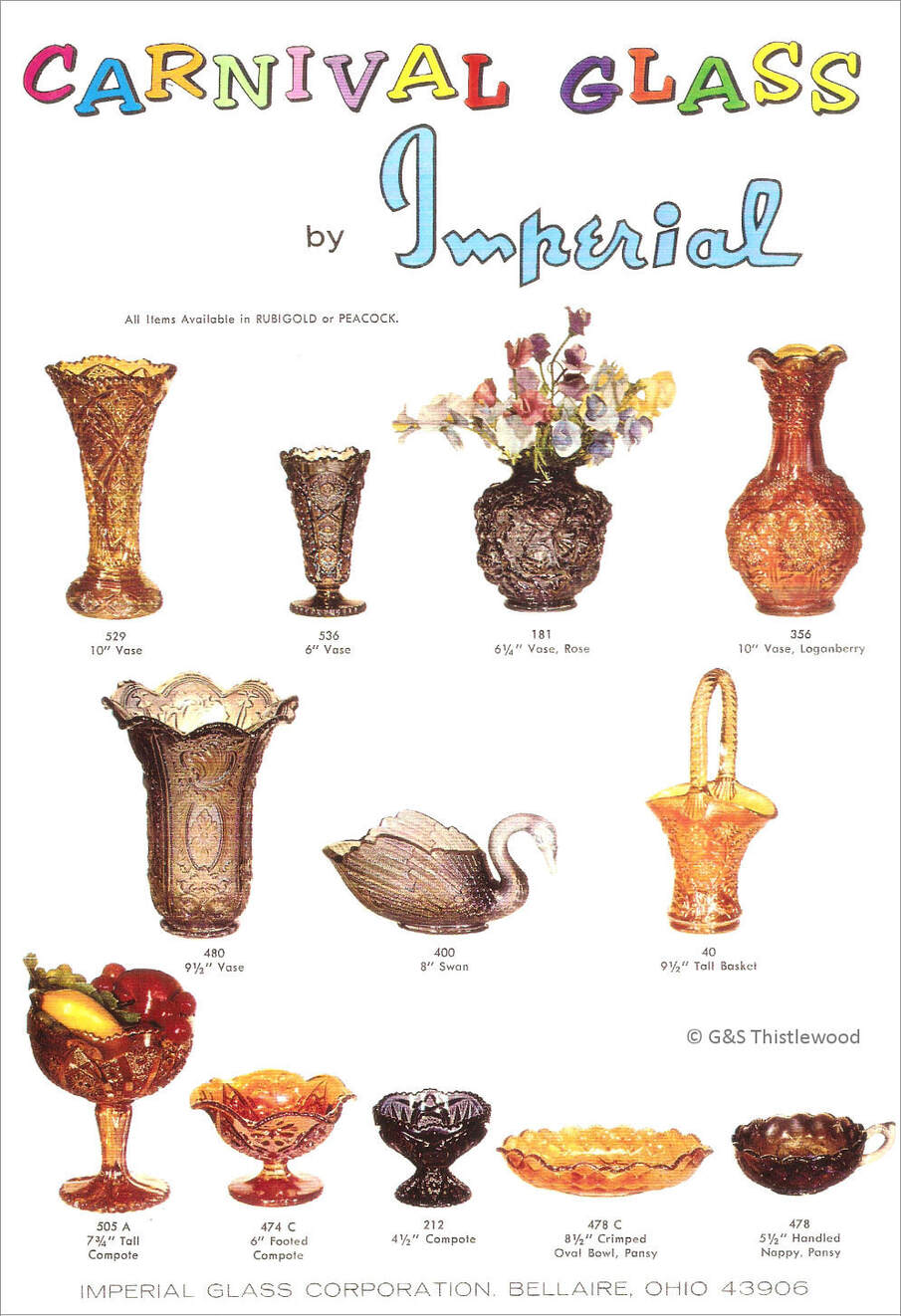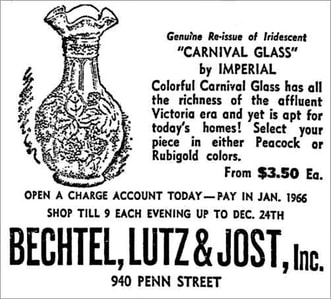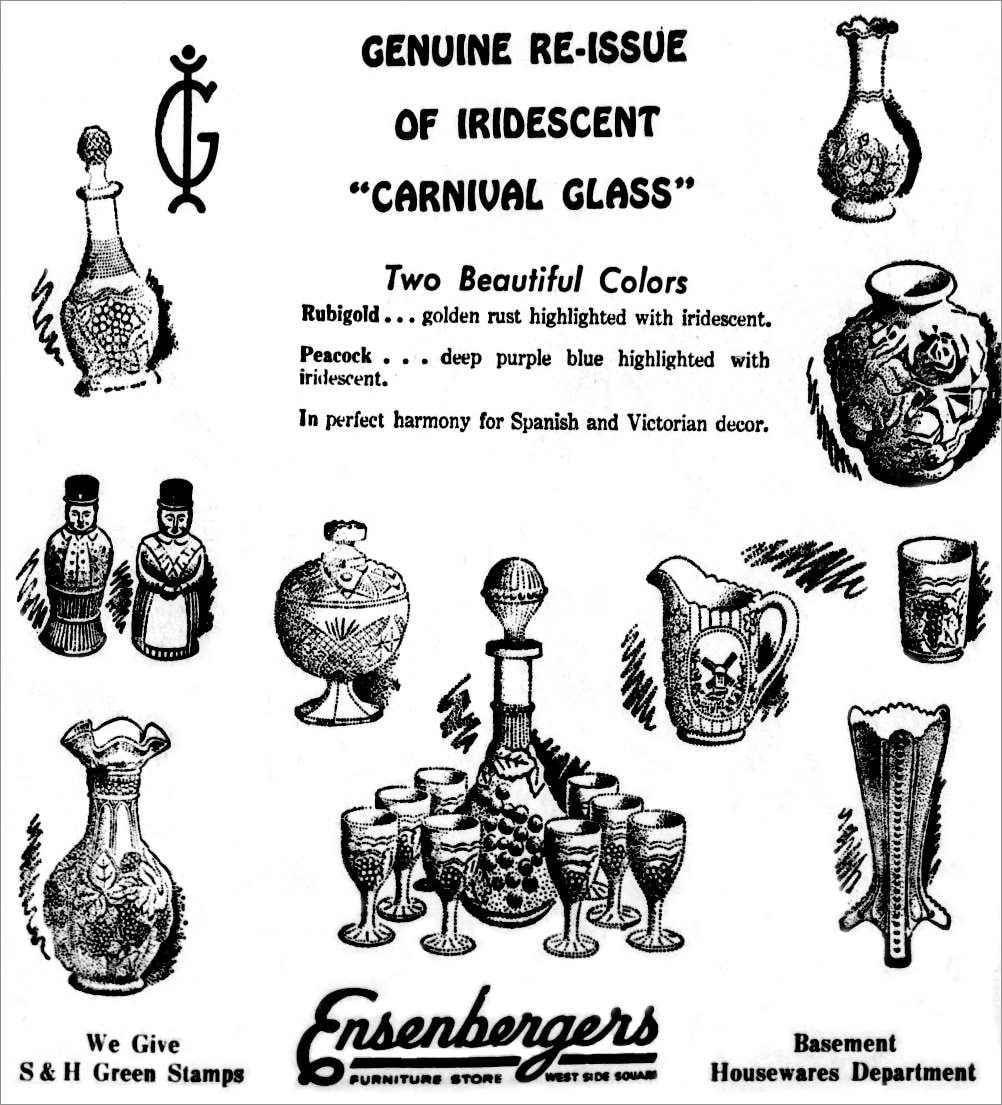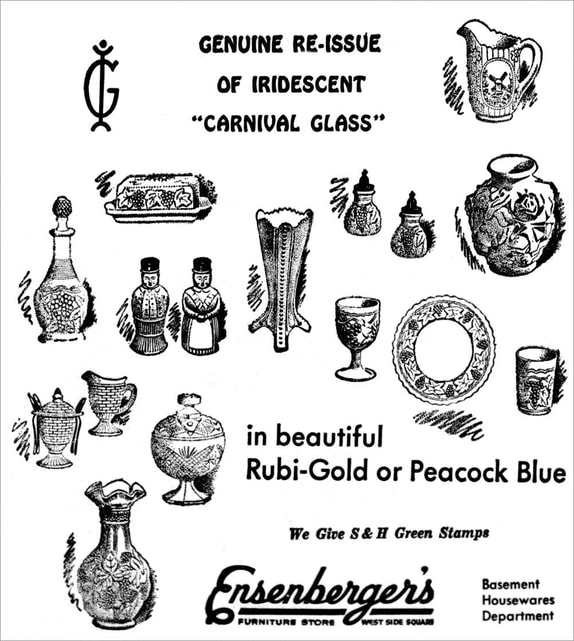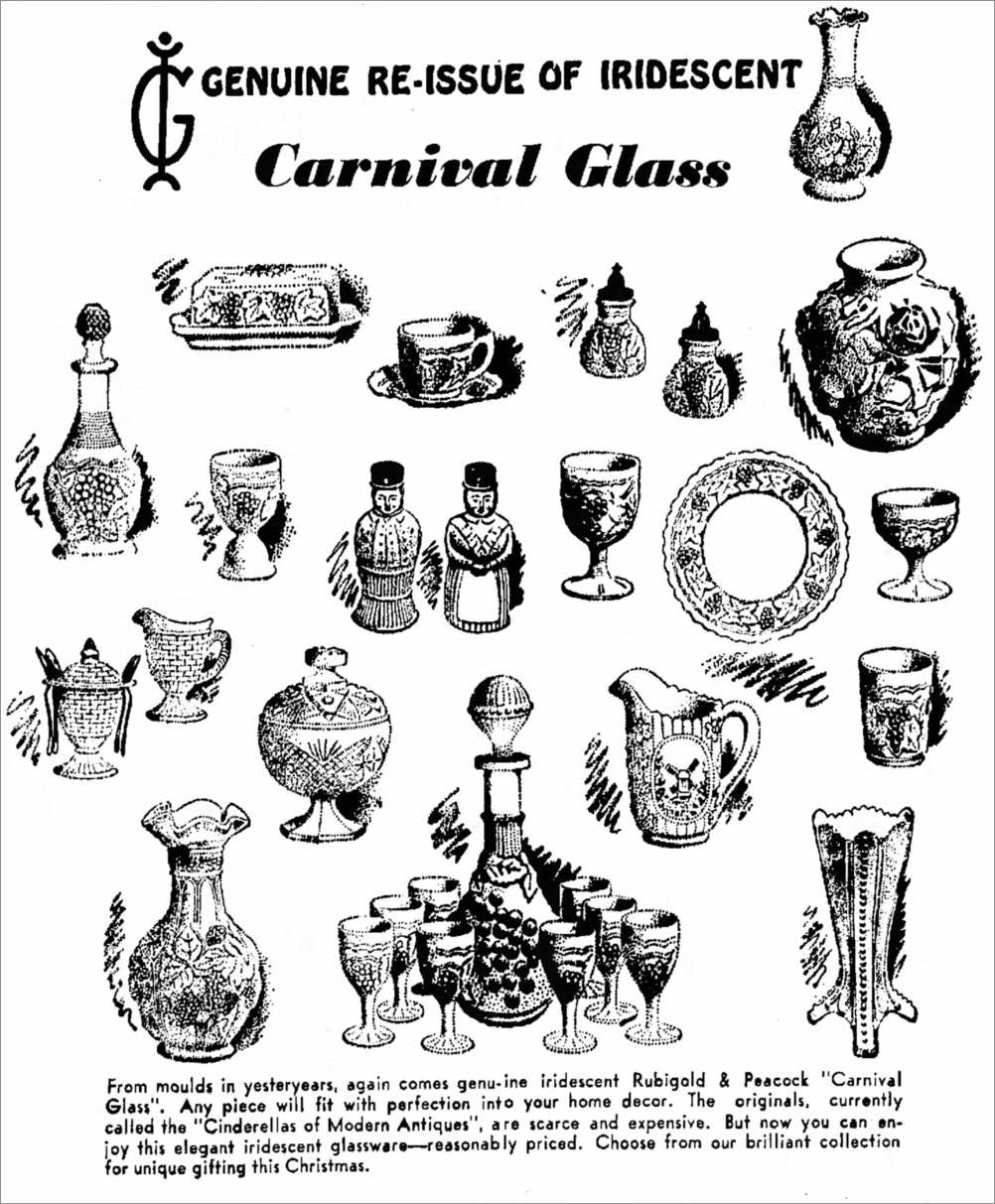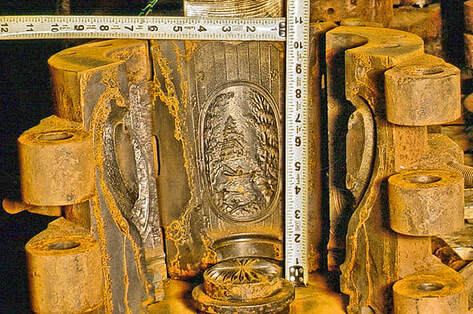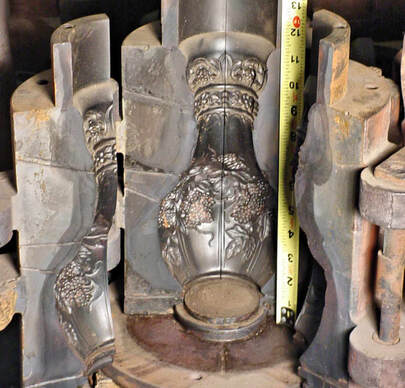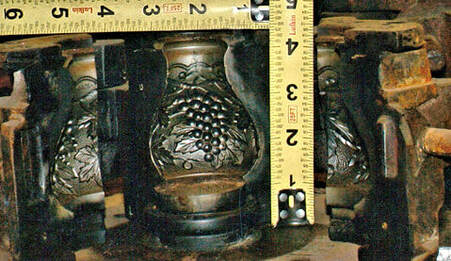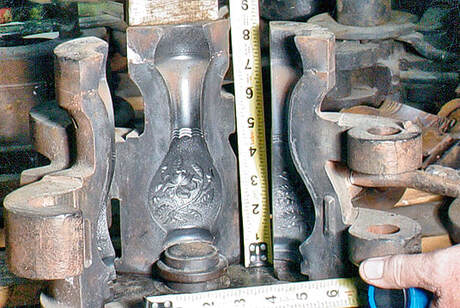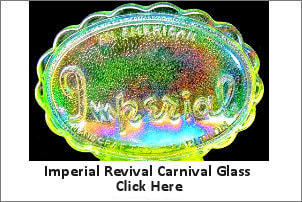Imperial in the 1960s: the Carnival Revival.
In the early 1960s, Imperial - as well as Fenton and other glassmakers - saw a developing market for the revival of Carnival Glass production. The 1960s re-issues were aimed directly at the collector market, and cleverly, Imperial utilised the name "Carnival", and revived many of their old Classic Carnival patterns. They had recognised that Classic (old) Carnival was very popular in collector circles, and that the name "Carnival Glass" was the generally accepted name for this collectable glass.
In a throwback to names they used for their Classic Carnival, Imperial revived the terms "Rubigold" and "Peacock" to describe their re-issued colours; Rubigold was marigold (just as it was for their Classic Carnival), whereas Peacock was now being used to denote their new smoke Carnival.
Here is a page from a pamphlet for Imperial's Revival Carnival from the late 1960s. The pamphlet was actually four pages - and we show all four of them here: Imperial's 4-page Revival pamphlet
|
Top row:
Hobstar and Fan 10" vase, #529 * Imperial #536 6" vase, sometimes called Lace Variant * La Bella Rose 6¼" vase, #181 Loganberry 10" vase, #356 * |
Middle row:
Scroll & Flower Panel 9½" vase, #480 * Master 8" Swan, #400 Daisy handled 9½" basket, #40 * |
Bottom row:
Imperial Lace (aka Octagon), #505A 7¾" compote * Four Seventy Four 6" footed compote, #474C * Imperial #212 4½" comport Pansy crimped oval 8½" bowl, #478C * and Pansy 5½" handled nappy, #478 * |
* See "The Moulds" section later for information about some of the moulds used in this revival.
The Advertising Campaign.
As you might expect, Imperial advertised their new Carnival Glass pieces with enthusiasm! They also emphasised that it was a revival of their original production of Carnival Glass: a "Genuine Re-issue", with "all the richness of the affluent Victorian era". It is rather ironic to see the use of "affluent" in respect of Classic (old) Carnival, when the reality was that the Classic production was very much aimed at the low price / mass market customers!
It is also notable how Ensenberger's Furniture Stores used S&H Green Stamps as a sales aid. We have looked extensively at the variety of sales aids that were used as far back as the Classic Carnival era, which you can see here: Stamp of Approval.
As you might expect, Imperial advertised their new Carnival Glass pieces with enthusiasm! They also emphasised that it was a revival of their original production of Carnival Glass: a "Genuine Re-issue", with "all the richness of the affluent Victorian era". It is rather ironic to see the use of "affluent" in respect of Classic (old) Carnival, when the reality was that the Classic production was very much aimed at the low price / mass market customers!
It is also notable how Ensenberger's Furniture Stores used S&H Green Stamps as a sales aid. We have looked extensively at the variety of sales aids that were used as far back as the Classic Carnival era, which you can see here: Stamp of Approval.
|
Above: an ad from the Reading Eagle, 1965: a Loganberry vase for $3.50.
The items shown in the 1965 ad on the right are:
Top row Left: Grape cruet and stopper (#241) Right: Rose / Imperial Rose vase (#108) and below it, La Bella Rose vase (#181) Middle section, left to right: Salz n Pfeffer salt and pepper set (#267) Eastern Star covered compote (#452) Windmill pitcher (#239) * Grape tumbler (#473) * Bottom row: Loganberry vase (#356) * Grape wine decanter and stopper and wines set (#163-decanter; #473-set) * Tri-Corn 3-footed vase (#192) * See "The Moulds" section later for information about some of the moulds used in this revival. |
Above: from The Pantagraph of June 25th. 1965.
|
|
Above: an ad in The Pantagraph - May 30th. 1966. Although the ad refers to "Peacock Blue", it is an advertising term describing the appearance of the iridescence. Carnival collectors refer to the colour of these items as smoke.
|
The items shown in the 1966 ad on the left are:
Windmill pitcher (#239) * Middle section, left to right:
Grape cruet and stopper (#241) Grape covered butter (#276) Salz n Pfeffer salt and pepper set (#267) Tri-Corn 3-footed vase (#192) Grape salt and pepper shaker set (#96) La Bella Rose vase (#181) Grape goblet (#473) * Grape 7½” plate (#3D) Grape tumbler (#473) * Lower section, left to right:
Basketweave footed creamer (#301) and covered sugar with spoon holder (#304) Eastern Star covered compote (#452) Bottom row, left:
Loganberry (#356) * * See "The Moulds" section later for information about some of the moulds used in this revival. |
|
The items shown in the 1967 ad on the right are: Top right: Rose / Imperial Rose vase (#108) Next row, left to right: Grape covered butter (#276) Grape cup and saucer (#4737) * Grape salt and pepper shaker set (#96) La Bella Rose vase (#181) Next row, left to right:
Grape cruet and stopper (#241) Grape egg cup / juice (#225) Salz n Pfeffer salt and pepper set (#267) Grape goblet (#473) * Grape 7½” plate (#3D) Grape sherbet (#473) Next row, left to right:
Basketweave footed creamer (#301) and covered sugar with spoon holder (#304) Eastern Star covered compote (#452) Windmill pitcher (#239) * Grape tumbler (#473) Bottom row, left to right:
Loganberry (#356) * Grape wine decanter and stopper and wines set (#163-decanter; #473-set) * Tri-Corn 3-footed vase (#192) * See "The Moulds" section later for information about some of the moulds used in this revival. This 1967 ad is particularly interesting in that it refers specifically to the price of Classic Carnival at that time. It states that the "originals [that is Classic, old Carnival] currently called the 'Cinderella of Modern Antiques', are scarce and expensive" Naturally, their new production was considered to be "reasonably priced"! |
Above: another ad in The Pantagraph - December 7th. 1967.
|
The Moulds
When Imperial re-issued Carnival Glass in the 1960s, it made economic sense for them to revive a number of old patterns and moulds that had previously been in use for Classic Carnival / EAPG production, as well as making entirely new moulds. In response to collectors of Classic Carnival, Imperial decided to mark their Contemporary Carnival production with their moulded Imperial mark (IG, LIG or ALIG).
Of the pieces shown in the 1960s catalogue and in the ads above, several of them had been made from moulds used before for Classic Carnival and/or EAPG, as indicated by * and listed below. Also, bear in mind that when Imperial closed, their moulds were sold; other glassmakers, notably Fenton and L. E. Smith acquired a large number of them, and many were subsequently used again by these two companies.
Imperial's 1960s ad
The old patterns/moulds to be seen are: Hobstar and Fan vase, Loganberry vase, Scroll and Flower Panel vase, Daisy basket, Four Seventy Four compote, Pansy oval bowl and Pansy handled nappy.
Also bear in mind that:
The Imperial #536 vase is an EAPG pattern / mould sometimes called Star & Cane by EAPG collectors. It was not made in Classic Carnival.
The Imperial #505A compote is shown in crystal glass in Imperial catalogues from the early 1900s, but is not known in Classic Carnival.
The Four Seventy Four compote in Classic Carnival has an 8-sided base, whereas the Contemporary pieces have a round base. The full fascinating story of the
Four Seventy Four pattern (OMN "La Rochelle") is told here: Imperial's Four Seventy Four - The Story Behind the Glass.
The Octagon pattern, originally called "The Bellaire" also has an amazing story - read it here: Imperial's Octagon - The Story Behind the Glass.
Bechtel, Lutz & Josh ad
The Loganberry vase is an old pattern/mould.
Pantagraph / Ensenberger's ads
The old patterns/moulds to be seen are: Windmill pitcher, Grape / Imperial Grape (decanter, stopper, wine, tumbler, goblet, cup and saucer), and Loganberry vase.
When Imperial re-issued Carnival Glass in the 1960s, it made economic sense for them to revive a number of old patterns and moulds that had previously been in use for Classic Carnival / EAPG production, as well as making entirely new moulds. In response to collectors of Classic Carnival, Imperial decided to mark their Contemporary Carnival production with their moulded Imperial mark (IG, LIG or ALIG).
Of the pieces shown in the 1960s catalogue and in the ads above, several of them had been made from moulds used before for Classic Carnival and/or EAPG, as indicated by * and listed below. Also, bear in mind that when Imperial closed, their moulds were sold; other glassmakers, notably Fenton and L. E. Smith acquired a large number of them, and many were subsequently used again by these two companies.
Imperial's 1960s ad
The old patterns/moulds to be seen are: Hobstar and Fan vase, Loganberry vase, Scroll and Flower Panel vase, Daisy basket, Four Seventy Four compote, Pansy oval bowl and Pansy handled nappy.
Also bear in mind that:
The Imperial #536 vase is an EAPG pattern / mould sometimes called Star & Cane by EAPG collectors. It was not made in Classic Carnival.
The Imperial #505A compote is shown in crystal glass in Imperial catalogues from the early 1900s, but is not known in Classic Carnival.
The Four Seventy Four compote in Classic Carnival has an 8-sided base, whereas the Contemporary pieces have a round base. The full fascinating story of the
Four Seventy Four pattern (OMN "La Rochelle") is told here: Imperial's Four Seventy Four - The Story Behind the Glass.
The Octagon pattern, originally called "The Bellaire" also has an amazing story - read it here: Imperial's Octagon - The Story Behind the Glass.
Bechtel, Lutz & Josh ad
The Loganberry vase is an old pattern/mould.
Pantagraph / Ensenberger's ads
The old patterns/moulds to be seen are: Windmill pitcher, Grape / Imperial Grape (decanter, stopper, wine, tumbler, goblet, cup and saucer), and Loganberry vase.
Here are some of the moulds that Imperial used for the pieces shown in the above ads. The Imperial moulds were subsequently acquired by Fenton, and these pictures of them are courtesy of the Fenton Family and Fenton Art Glass Company.
And here are two of the Imperial blow moulds that were used for Imperial's Contemporary production - they were not used to make Classic Carnival.
See more Imperial Revival Carnival catalogues, ads and related pattern information.
|
We have many more Imperial Revival Carnival Glass catalogues and ads,
covering the period from the 1960s through to their closure in 1984. They are all accessed from our Imperial Revival Homepage. Click on the image on the left, or go here: Imperial Revival Carnival |
